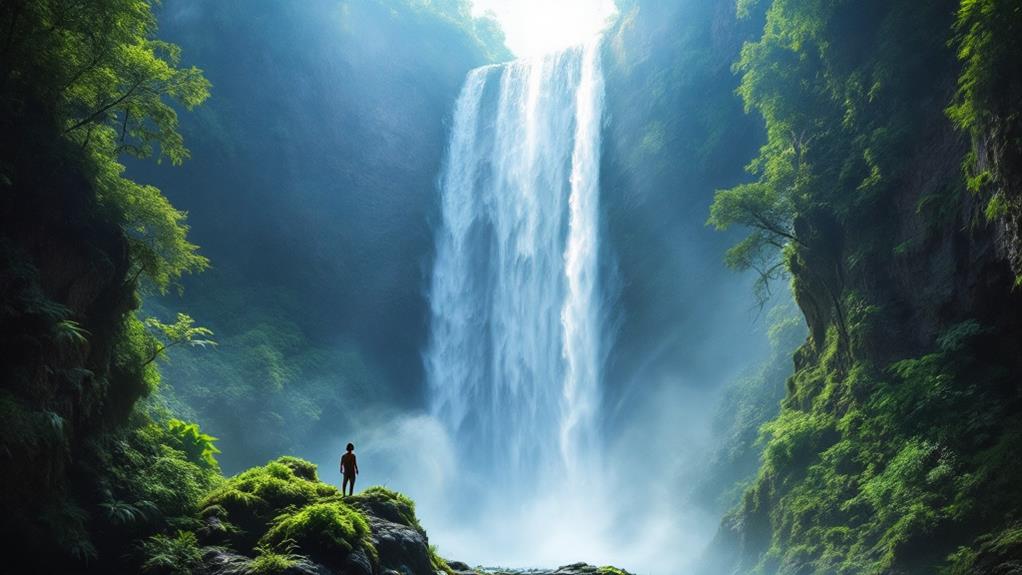Animals That Can Walk on Water: Nature’s Incredible Feats
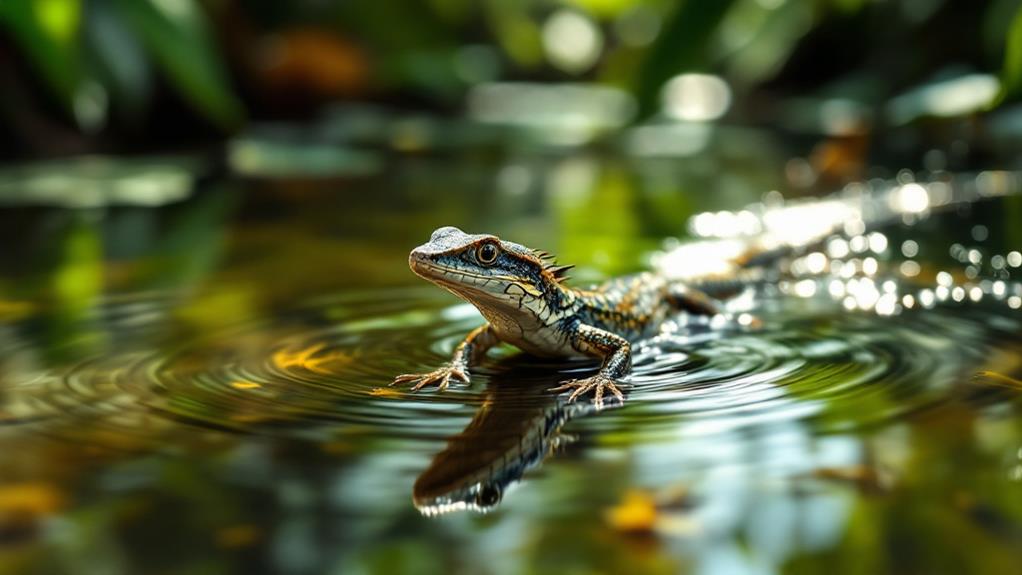
You'll be amazed by the diverse array of animals that can walk on water. From tiny water striders using surface tension to basilisk lizards sprinting across the surface, nature has evolved incredible adaptations. Fishing spiders hunt on water's surface, while western grebes perform elaborate courtship displays. Storm petrels skim the waves during long ocean expeditions, and sailfish use their speed to chase prey near the surface. These animals showcase various methods, including specialized leg structures, rapid movements, and water-repellent surfaces. Their abilities have even inspired human technologies. Explore how these extraordinary creatures defy gravity and glide effortlessly across liquid surfaces.
The Science Behind Water Walking
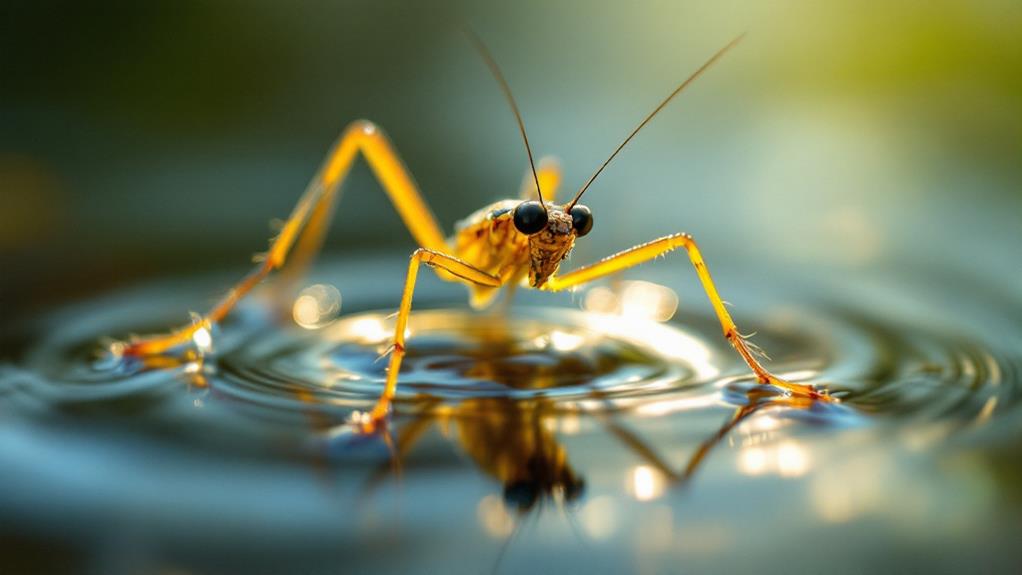
Several fascinating principles of physics allow certain animals to walk on water. The key to this remarkable ability lies in understanding surface tension properties and water repelling mechanisms. Surface tension creates a thin, elastic film on the water's surface, which can support light objects if the force is distributed appropriately.
You'll find that water-walking animals have adapted specialized body structures to take advantage of this phenomenon. They often possess hydrophobic (water-repelling) surfaces on their feet or bodies, which prevent them from breaking through the water's surface film. These adaptations can include tiny hairs, waxy coatings, or specially shaped appendages that distribute their weight effectively.
Some animals also utilize a technique called dynamic water walking, where they generate enough force through rapid leg movements to stay afloat. This method relies on the principle that water resists sudden forces, temporarily behaving more like a solid.
Understanding these mechanisms has inspired scientists to develop water-walking robots and innovative materials that mimic nature's designs. By studying these animals, we gain knowledge into fluid dynamics and potential applications in fields like robotics and materials science.
Basilisk Lizards: The Jesus Christ
Nicknamed the "Jesus Christ lizard," the basilisk lizard is one of nature's most impressive water walkers. You'll find these remarkable reptiles in the tropical rainforests of Central and South America, where they've perfected their unique locomotion across water surfaces.
When threatened, basilisk lizards can sprint across water at speeds up to 5 feet per second. Their water walking abilities stem from a combination of physical adaptations and technique. They have long toes with fringed scales that increase surface area, allowing them to create tiny air pockets as they slap the water's surface. This, coupled with their rapid stride, keeps them afloat.
As they run, basilisks use their tails for balance and propulsion. Their hind legs move in a circular motion, much like bicycle pedals, generating enough force to keep them above water. However, this feat isn't sustainable for long distances. After about 10-20 meters, they'll either plunge into the water or reach land.
You'd be amazed to see these lizards in action. Their water walking prowess is a showcase of nature's ingenious adaptations, allowing them to evade predators and survive in their challenging environment.
Water Striders: Masters of Surface
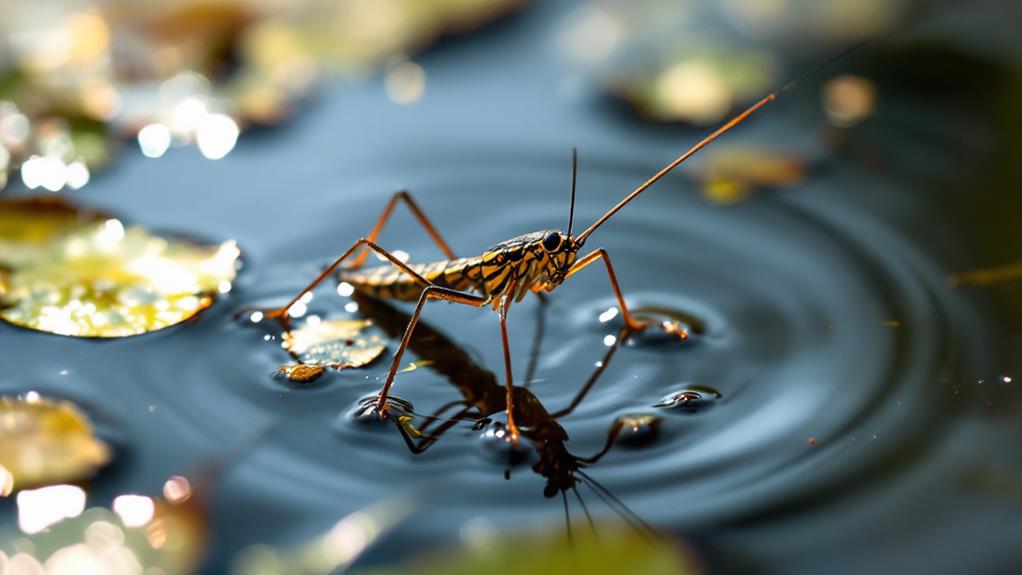
Water striders, also known as pond skaters, are true experts of surface tension. These fascinating insects have conquered the art of walking on water through their unique body structure and specialized legs. Their ability to navigate the water's surface is a result of their advanced understanding of surface tension dynamics and water meniscus management.
When you observe water striders, you'll notice four key features that contribute to their water-walking prowess:
- Hydrophobic legs covered in tiny hairs that repel water
- Distributed weight across six long, slender legs
- Claws positioned away from the water's surface
- Ability to sense and react to water vibrations
You'll be amazed at how effortlessly these insects glide across ponds and streams. Their legs create small dimples in the water's surface without breaking through, allowing them to stay afloat. Water striders use this skill to hunt for prey, mate, and avoid predators. They're so adept at manipulating surface tension that they can even jump on water to escape danger. Next time you're near a body of water, keep an eye out for these exceptional creatures demonstrating nature's ingenious adaptations.
Fishing Spiders: Aquatic Arachnids
Another impressive water-walker you'll encounter is the fishing spider. These aquatic arachnids have mastered water locomotion, effortlessly gliding across pond surfaces and even plunging beneath to catch prey. Unlike their terrestrial cousins, fishing spiders have adapted to life on and under the water.
You'll notice their long legs, which are covered in tiny, water-repellent hairs. These hairs create a layer of air around their legs, allowing them to stay buoyant and move swiftly across the water's surface. When hunting, fishing spiders use the water's surface tension to detect vibrations from potential prey.
Their aquatic hunting strategies are remarkably diverse. You might spot them skating on the water's surface, waiting to ambush insects that fall in. They can also submerge underwater to catch small fish and tadpoles, using their air-coated bodies to breathe while submerged. Some fishing spiders even "fish" by dangling their front legs in the water to lure prey.
These adaptable arachnids demonstrate nature's ingenuity in conquering diverse habitats. Their ability to walk on water and hunt both above and below the surface makes them fascinating subjects for study within the domain of water-walking creatures.
Western Grebe: Dancing on Water
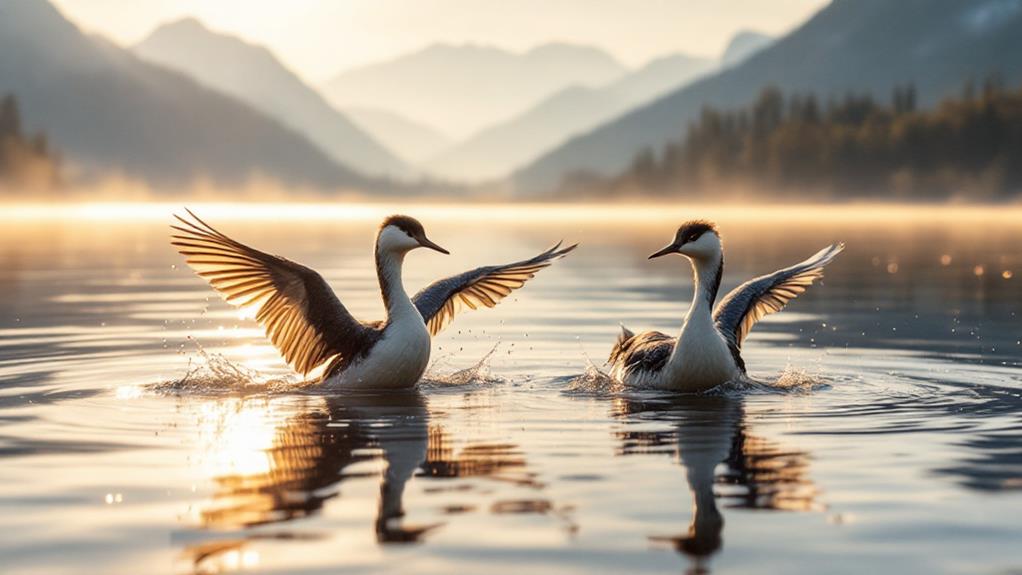
When it comes to aquatic ballet, the Western Grebe steals the show. These stylish water birds are known for their incredible ability to run across the water's surface during courtship displays. You'll be amazed by their grace and agility as they perform this stunning feat.
Western Grebes use their water-walking skills for both courtship and hunting strategies. Here's what makes their performance so impressive:
- Speed: They can reach speeds up to 20 mph while running on water
- Distance: Grebes can cover up to 65 feet in a single run
- Precision: They use their webbed feet to create tiny air pockets beneath them
- Synchronization: Mating pairs often perform the dance in perfect unison
Their unique anatomy allows them to execute this remarkable behavior. With legs positioned far back on their bodies, Western Grebes can generate powerful thrust to propel themselves across the water's surface. During courtship displays, you'll see pairs rushing side by side, their necks arched and bills pointed skyward. This spectacular performance not only serves to attract mates but also demonstrates the birds' strength and fitness.
Pygmy Gecko: Tiny Water Walker
From among the smallest creatures capable of water walking, the pygmy gecko stands out as a true marvel of nature. You'll find these tiny lizards skittering across the surface of water with ease, thanks to their unique adaptations for miniature size. Their diminutive bodies, typically measuring less than an inch in length, are covered in microscopic hairs that repel water and create surface tension.
When threatened, pygmy geckos employ their water-walking ability as one of their strategies for evading predators. They can dash across water surfaces at incredible speeds, reaching up to 1 meter per second. This feat is made possible by their specialized toe pads, which are covered in thousands of hair-like structures called setae. These setae interact with water molecules, allowing the gecko to distribute its weight evenly and prevent sinking.
You'll be amazed to learn that pygmy geckos can even change direction mid-stride on water, a demonstration of their agility and control. Their water-walking ability isn't just for show – it's a vital survival skill that helps these tiny reptiles thrive in their tropical habitats.
Storm Petrels: Seabirds Touching Waves
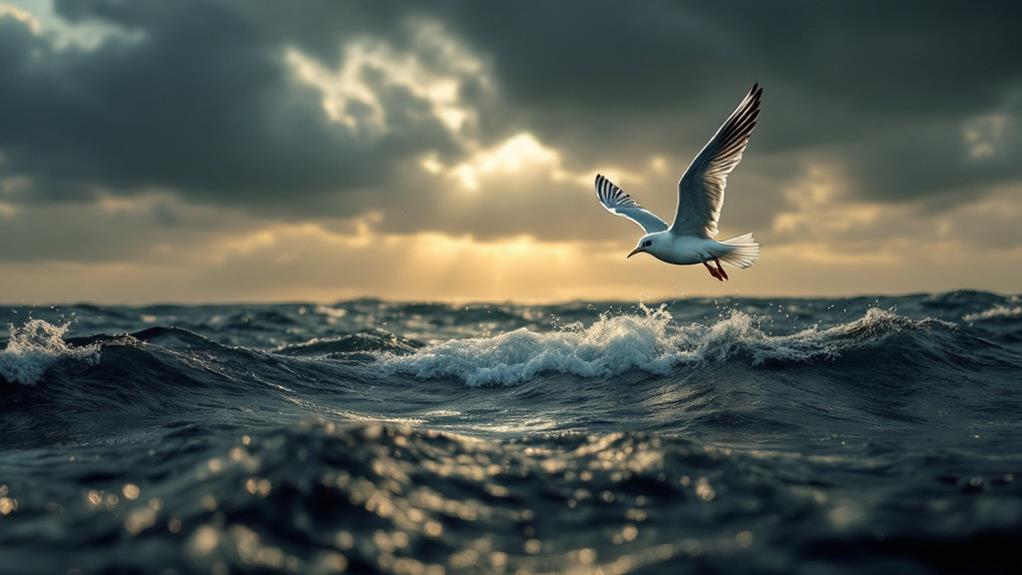
Seabirds with a unique talent, storm petrels can seemingly walk on water as they skim the ocean's surface. These small, agile birds use their long legs and webbed feet to dance across the waves, creating an illusion of walking on water. Their remarkable water feeding behavior allows them to snatch tiny marine creatures and plankton while in flight or hovering just above the water's surface.
Storm petrels have adapted to life at sea, spending most of their time over open waters. They only return to land for nesting habits, typically on remote islands or coastal cliffs. These fascinating birds exhibit several unique characteristics:
- They're nocturnal, returning to their nests under the cover of darkness to avoid predators.
- Their keen sense of smell helps them locate food sources from great distances.
- Some species can fly for up to 10 months without touching land.
- They have a specialized gland that allows them to drink seawater and excrete excess salt.
You'll find storm petrels in oceans worldwide, from the tropics to polar regions. Their ability to "walk on water" is a remarkable testament to nature's incredible adaptations, allowing these seabirds to thrive in challenging marine environments.
Sailfish: Skimming Ocean Surfaces
Gliding effortlessly across the ocean's surface, sailfish showcase their astounding ability to "walk on water." These swift predators use their large dorsal fins and streamlined bodies to skim the waves at incredible speeds, often reaching up to 68 mph.
You'll be amazed by the sailfish's hydrodynamic efficiency, which allows it to move with minimal resistance through the water. Their bodies are designed to reduce drag, with a pointed bill and a crescent-shaped tail that propels them forward with powerful force. The sailfish's skin is covered in tiny scales that enhance water repellency, further reducing friction as they slice through the waves.
When hunting, sailfish use their "water-walking" ability to their advantage. They'll chase schools of fish near the surface, using their speed and agility to corral their prey. As they skim across the water, they'll slash at their targets with their bills, stunning or injuring them before consuming them.
This unique ability to "walk on water" isn't just for show – it's an essential survival skill that helps sailfish maintain their status as one of the ocean's top predators.
Evolution of Water-Walking Adaptations
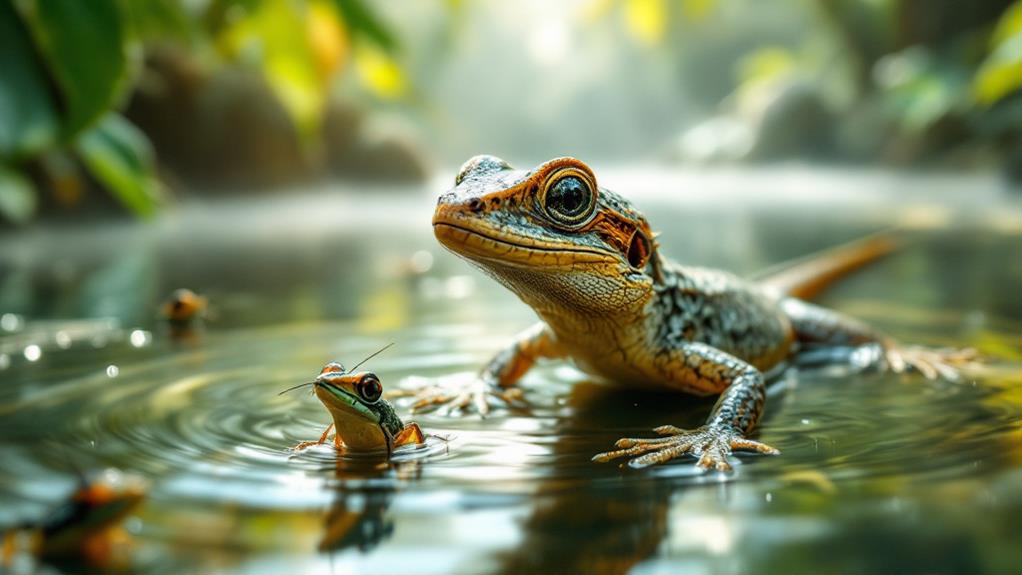
Over millions of years, nature has fine-tuned the astonishing adaptations that allow certain animals to walk on water. These exceptional aquatic locomotion mechanisms have evolved through a process of natural selection, with each species developing unique strategies to conquer the water's surface.
You'll find that water-walking adaptations have emerged independently in various animal groups, showcasing nature's ingenuity. The evolution of these abilities has led to four primary methods:
- Surface tension exploitation (e.g., water striders)
- Rapid leg movements (e.g., basilisk lizards)
- Specialized foot structures (e.g., fishing spiders)
- Hydrodynamic forces utilization (e.g., western grebes)
As you investigate these adaptations, you'll notice how they've inspired biomimicry of water walking in human technology. Engineers and scientists are studying these creatures to develop innovative solutions for water-based locomotion and even robotic designs.
The evolution of water-walking abilities demonstrates nature's capacity for problem-solving. By observing and understanding these adaptations, you're witnessing the results of countless generations of refinement, each contributing to the exceptional feat of defying gravity on water's surface.
Human-Inspired Water-Walking Technologies
Nature's ingenious water-walking adaptations have sparked a wave of innovation in human technology. You'll find scientists and engineers drawing inspiration from water striders, basilisk lizards, and other aquatic acrobats to develop bioinspired water walking devices.
These human-made creations aim to mimic the water walking mechanisms found in nature. You'll see robots equipped with hydrophobic legs that can glide across water surfaces, much like their animal counterparts. Some designs incorporate tiny hairs or grooves to trap air bubbles, enhancing buoyancy and reducing friction.
Researchers have also developed materials that replicate the water-repellent properties of certain animals' skin and feet. These advancements have led to the creation of water-walking shoes and even small vehicles that can traverse liquid surfaces.
The applications for these technologies are diverse. You might encounter them in search and rescue operations, environmental monitoring, or even recreational activities. As our understanding of nature's water-walking adaptations grows, so does our ability to create more efficient and effective human-inspired solutions. The future may hold even more impressive water-walking technologies that exceed the limits of what we once thought possible.

